Your cart is empty
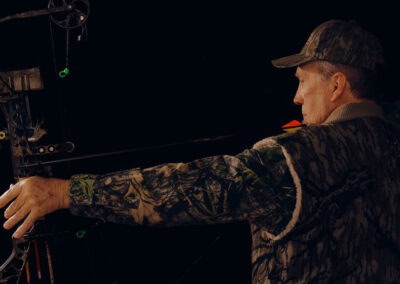

The only place a wolf can be a devil or a saint is in the eye of the beholder.
Story by
Photos
Rob Green
Read Time
25 minutes
Posted
Part 1: Tracks in the Haze
The dust that’s been chasing us swirls around the headlights and spills over the tires as the pickup skids to a stop. By the time I’ve cursed the cheap, Jetboiled coffee I’ve spilled across my lap, Wendy’s already flung the door open and is gliding around the back of the truck. From the driver’s seat of a half-ton Dodge going 35 miles an hour down a gravel road in the faintest morning light, she’s seen something I missed. Her eyes dart to the forest and then back down the road. The wolf was just here. It is still close.
I walk around the tailgate and find her huddled over a fresh pile of wolf scat, still steaming in the cold. Finding wet feces is akin to striking gold in certain corners of the wildlife tracking community, and tracker that she is, Wendy is staring at a warm, squishy mother lode. She picks up a stick and prods to investigate.
“You’ve got to be fucking kidding me,” she says under her breath.
Sure enough, there it is: deer hair, bone fragments. Still a little tarry. It had been eating organ meat. In the twenty minutes since we first came down this section of the route, the wolf had emerged from the woods, left its mark, and vanished. Wendy squints and says, “Four,” to no one in particular. Remembering I’m there, she points to four nearly imperceptible sets of tracks that show where the pack had crossed our own and then faded back into the ponderosas and larch trees that are just starting to turn for the fall.
“Just because you can’t see them doesn’t mean they’re not there. The only wolves up here are either smart, lucky, or new.”
FWP Technician, April Wood
Beyond them, the pink sun creeps over the canopy — another day of wildfire smoke blowing in from Idaho is ahead of us. We’ve been out here a full week, and the entire time we’ve been stuck under a lung-tightening haze that makes everything smell and taste like campfire. You try to cough it up and sneeze it out, but it is everywhere and ever-present. Less than ten miles from the Canadian border, this section of Kootenai National Forest has some of the densest wildlife habitat Montana has to offer — thick tree cover, few maintained roads, steep terrain — but we can’t really see much of it. The Cabinet Mountains should be right there towering over the landscape but they remain hidden behind the choking veil.
Another pickup rolls up with a faded “Montana Fish, Wildlife & Parks” logo on the door. It’s April. She’s been checking traps from the other direction, looking for signs of the Thirsty Lake Pack they’ve been following for the past week. She rolls down the window.
“I’m going to set,” Wendy says. She pulls her blond hair back into a tight ponytail before donning work gloves and Xtratuf rubber boots to minimize her scent.
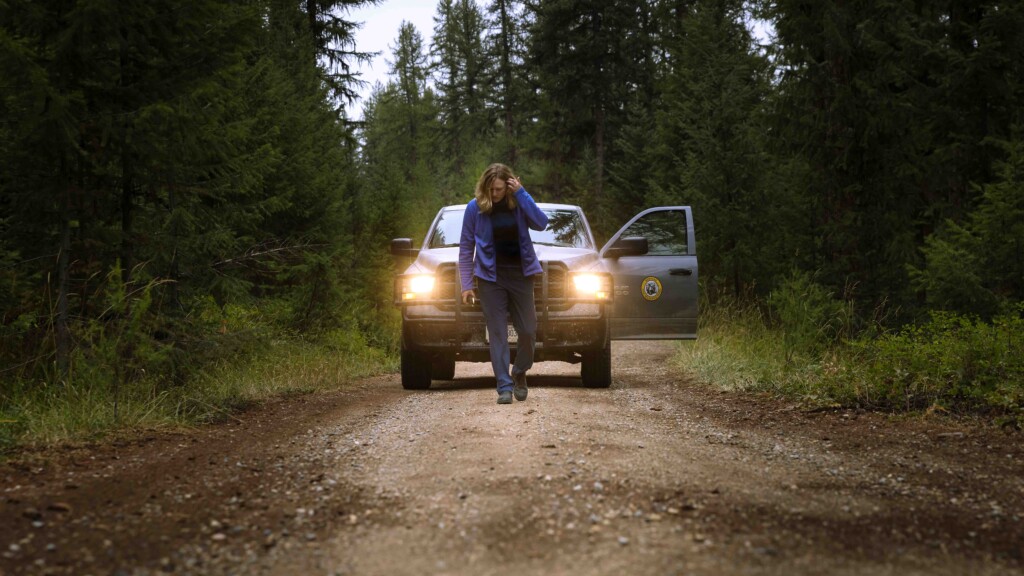
Wendy Cole is the Montana Fish, Wildlife & Parks (FWP) wolf specialist for Region 1, an area nearly the size of Belgium in the northwestern corner of the state. It’s home to some of North America’s most iconic wildlife: grizzly and black bear, mountain lion, lynx, elk, deer, moose, mountain goat, bighorn sheep — and more wolves than any other region in Montana. She and her technician, April Wood, are tasked with finding, collaring, and monitoring wolves in the 11,000-square-mile area they’re responsible for. The GPS data from the ones they’re trying to collar now could lead to a trove of information on pack movement, dispersal, and changes in behavior that carries the potential to impact the state’s approach to wolf management. With the stakes surrounding wolves as high as they have been in recent years, that information means everything.
The two come up with a plan for each of their traps, and April drives farther down to start a site of her own. This is the first good sign they’ve seen since they got here. Everything else has been old scat and weathered tracks. Wendy is not discouraged.
“Just because you can’t see them doesn’t mean they’re not there,” she says. “The only wolves up here are either smart, lucky, or new.”
These are not Yellowstone wolves they’re after. These are wolves that nobody really talks about because they’re harder to see and even harder to catch. They are ghosts that slip in and out of the forest, leaving only a gossamer of sign for those able to detect it. There are no hordes of fat-walleted, binocular-clad tourists training their Leicas on the Lamar Valley and naming wolves that are protected and, by comparison, unpressured. These wolves are hunted, trapped and hazed on a regular basis and in greater numbers. In the most contested areas just north of Yellowstone National Park, 21 wolves were killed in 2021, and the public outcries were heard across the country. In the area where Wendy and April are now, 52 wolves were killed over the same timeframe with barely a peep from the pro-wolf crowd. With that kind of hunting pressure, the wolves that survive here are savvy.
Wendy hauls a double-long spring trap from a black Rubbermaid in the truck bed. It’s a piece of technology that is exactly what you imagine when you think of old-timey trappers from a century ago. That’s because not much has changed in the past hundred years. It hasn’t had to. The trap’s two bent metal “ears” reliably spring a pair of jaws closed around the foot of anything that steps onto the trigger pan with enough force to set it off.
This business of setting traps? This is a delicate art: What’s true in real estate is true in wolf trapping: location, location, location. Not too sunny so the wolf doesn’t overheat while it’s trapped, not near water so it can’t inadvertently drown itself, not on an overly trafficked road where someone might stop to shoot it, but one that wolves would use as a highway to patrol their territory. Once you’ve landed on the right spot, don’t sweat, don’t eat, don’t piss, don’t spit, don’t sneeze near the area if you can avoid it. Keep your scent out as much as possible. Open the jaws and set the pan tension and trigger — stiff enough to not trap a fox or coyote, but soft enough to catch a cautious wolf. God forbid you catch a bear. Dig down six to eight inches. Hammer in the earth anchor. Activate and bury the radio transmitter to help you know when you’ve got something. Set the trap. Use a sifting box to gently replace soil over the jaws to disguise the trap without bogging it down. Tamp it down. Cover with pine needles and moss. Apply lure just far enough away so that a wolf has to take that one extra step toward the scent to set a paw down on the pan (the sweet, musky, beaver-anal-gland-scented “Violator” is a popular choice). If all goes well, you’ve done this entire process in less than 30 minutes. When nobody else knows your trap is there, you got it right.
Wendy stands up to admire her work and brushes away a strand of hair that’s fallen across her face. The irony isn’t lost here. In many ways, she shares a skill set with the hunters and trappers who will soon be in these same forests to kill the wolves she’s paid to study. I ask if she feels confident in the site.
“We’re trying to get an animal with a 175-square-mile territory to step on a pan that’s two inches wide,” she says. “Part of it is learning to think like a wolf: Where are they hunting? When will they rest? What are the pathways for potential threats? What are easy routes for them to take?”
“What’s the other part?”
She heaves her tool bucket up into the bed of the truck, closes the tailgate, and smiles. “Luck.”
Part 2: The Commission & The Count
“AaaaaaOOOOOOOOOOOOoooorrr!” Wendy un-cups her hands from her mouth and listens to her howl bounce around the trees. She eyes the ravens overhead. Another creature known for its intelligence, ravens have been well documented for their ability to recognize wolves’ hunting cries, follow them along a chase, and then scavenge whatever carrion is left behind by the pack or flat-out stolen from under their noses. To see them circling could mean there’s a fresh kill nearby.
April joins in and the two take turns calling, hoping for a response that would indicate a pack’s general distance and direction. While their calls showcase enough talent to audition as canid voiceover actors for the next Planet Earth series, the wolves they’re after are either not convinced or not interested.
But one thing is certain: there are wolves here. A lot of wolves.

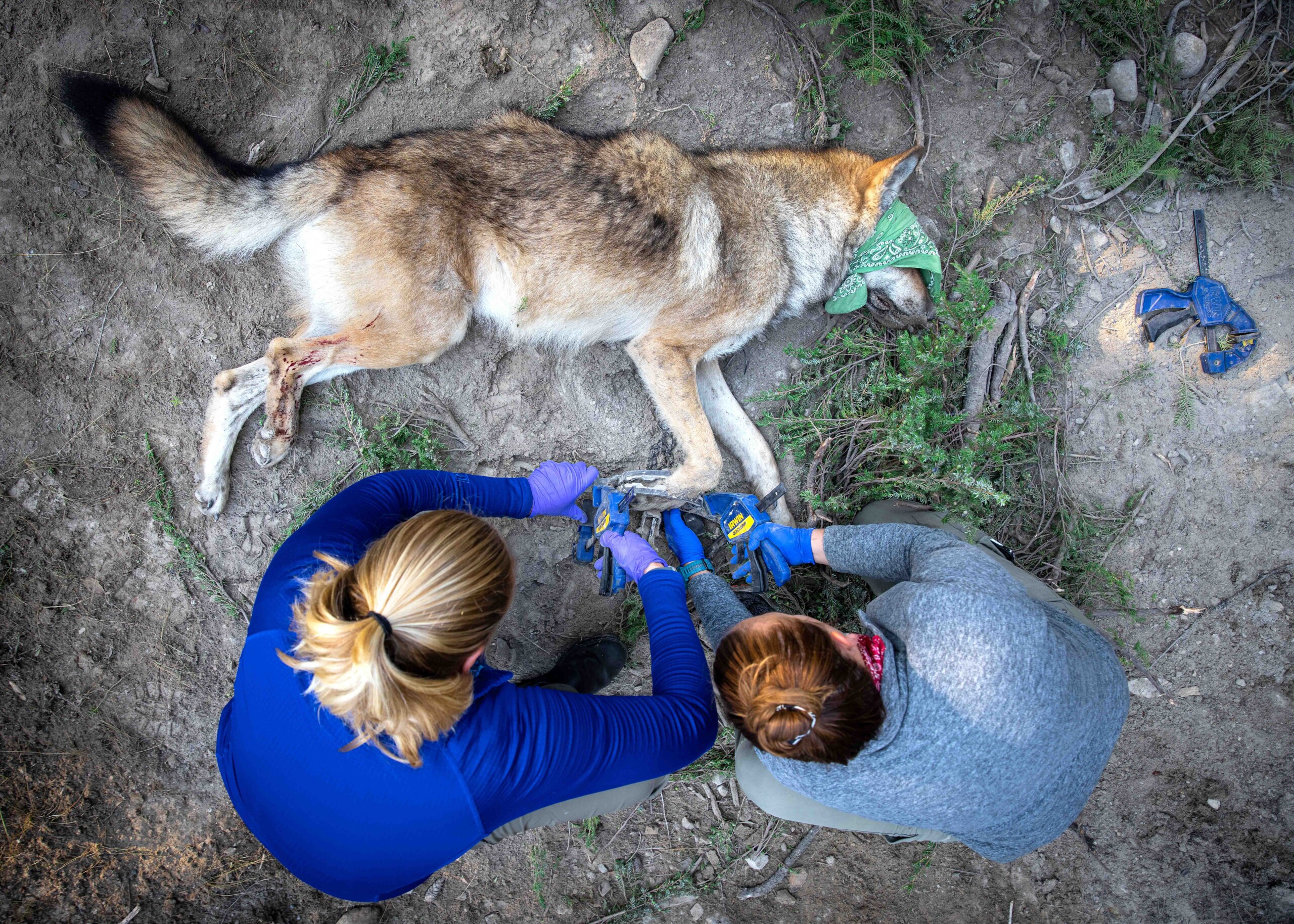
With regard to wildlife management, Montana is divided into seven regions, each with its own specialists and technicians. Within those regions are subregions called Wolf Management Units, or WMUs. This allows specialists to get a more granular understanding of specific landscapes, populations, and importantly, how many wolves can be hunted or trapped in a particular area without threatening the species’ overall health. The ground Wendy and April are standing on in Region 1 is currently home to more wolves than any other part of the state.
It wasn’t always this way. With the exception of a few stragglers that might have strolled down from Canada, wolves were extirpated from Montana by the 1930s through government-sanctioned bounty and eradication programs meant to trap, poison, and kill predators in an effort to clear the West for livestock. By the time they were listed under the Endangered Species Act (ESA) in 1978, nearly every one of the estimated two million gray wolves that historically roamed the present-day United States had been removed. Their endangered status facilitated a recovery that included both reintroduction efforts and natural reintegration from packs moving south from Canada. When given the space and time, wolves rebound quickly, with breeding females birthing as many as six pups in a single litter. After only 30 years of its ESA listing, Montana’s wolf population had grown from 10 individuals to nearly 1,200. As their numbers increased, so too did a renewed pressure for a hunt. After wildlife commissioners and state legislators determined there were enough wolves on the landscape to sustain an annual harvest, a wolf hunting season was opened in 2009.
These hunting and subsequent trapping seasons were turbocharged in 2021 when Governor Greg Gianforte oversaw a suite of new bills that fundamentally changed the way wolf hunting and trapping are regulated in Montana. Some of the now-infamous legislation includes Senate Bill 314, which allows for the use of baiting and night hunting, and the opportunity for the Montana Fish and Wildlife Commission to authorize unlimited tags for a single hunter or trapper, as well as House Bills 224 and 225, which add snaring as an acceptable method for killing wolves and extend the duration of hunting and trapping seasons from previous years.
Additionally, the commission is tasked with setting regulations, approving certain property acquisitions, and approving rules for FWP. It also has the ability to change WMUs entirely.
At their August 2022 meeting, Montana commissioners decided to combine the two WMUs immediately north of Yellowstone National Park into the controversial WMU 313. Additionally, they changed the wolf harvest quota in the new unit to six wolves, which reined in the unlimited quota from the previous year that saw 21 wolves killed. Pro-wolf and pro-trapping advocates alike showed up to the Helena meeting from all over the US — even the UK — to express their outrage or support for the commission’s decision.
The thing is, it’s not really Montana’s wolves they’re arguing over: it’s Wyoming’s. Looking at a map of the state, WMU 313 lies just north of the Wyoming border and adjacent to Yellowstone’s northern boundary. The wolves killed in this subregion are almost exclusively those that wander in from the Park and are promptly shot by hunters waiting for them. With no lethal human pressure taking place inside Yellowstone, these wolves aren’t as aloof or cautious as those in unprotected areas.
But wolves coming over from Yellowstone — Wyoming’s wolves — are only a small part of wolf management as a whole. If the commission’s goal was to deflect dealing with larger issues of accurate population counts or hunting quotas in other parts of Montana by using the Park as a distraction, it worked. Nobody understands that better than Doug Smith. As Yellowstone’s senior wolf biologist, his career has spanned some 44 years, and in that time he’s learned just as much about political landscapes as natural ones. He reflects on what these new changes to WMU 313 mean for Montana’s wolves. “To a degree, it’s a victory for the commission,” he says. “They used Yellowstone as a total diversion away from wolf management issues across the state. The wolves in Montana got nothing.” Yellowstone, rightfully, is the poster child for wolf conservation. Aside from its successful wolf reintroduction in 1995 that Doug helped conduct, it’s also a mecca for wildlife viewing that’s captured the hearts and minds of people the world over. The Park’s gift shops sell wolf books, plush toys, keychains, magnets, T-shirts, and other shiny objects that distract your run-of-the-mill tourist from broader conservation and management dilemmas. For all the awareness Yellowstone has helped bring about, Doug encourages people to look beyond its borders and see how species fit into larger ecosystems.
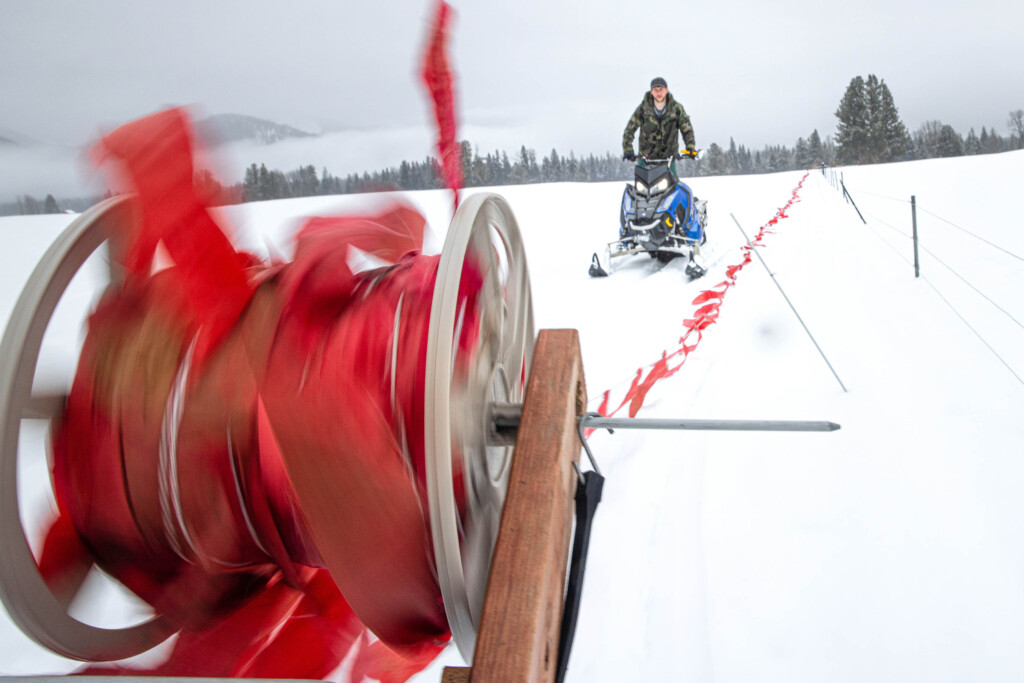
“Yellowstone gets a lot of media attention, and so that’s what’s on the news,” he says. “Less so about wolf management across Montana as a whole. I think that’s bad. Yellowstone is one of the greatest wolf preserves in the country. Last winter we had [a hunting season] that ate away at that, and that deserves attention, but so does a lot of what happens for wolves across the rest of Montana.”
What ultimately happens with wolves in the state has everything to do with numbers, and that bit about how “numbers don’t lie”? Well, that might not always be the case. In order to determine how many wolves you can kill without hurting the overall population, you need to know how many wolves you’re starting with. Montana’s tool for determining this equation is the Integrated Patch Occupancy Model, (iPOM). This approach uses three models — territory, occupancy and groups — to arrive at a defensible wolf count for the state. With limited resources that restrict FWP’s ability to conduct more on-the-ground, comprehensive studies like the tracking and collaring Wendy and April are doing, iPOM serves as a way to estimate how many wolves are in the state without having to physically tag them. Montana is the only state to take this approach. According to the model, there were roughly 1,144 wolves in Montana in 2021, but some argue that the inputs used to arrive at that number are flawed.
Dan MacNulty is an associate professor at Utah State University, and in addition to being involved with the Yellowstone Wolf Project alongside Doug Smith, he has been working to identify gaps in the iPOM estimates.
“The bottom line is that there’s still an imperfect understanding among scientists about how iPOM works,” he says. “Montana is counting packs that spend most of their time in neighboring states or Canada. What that means is Montana, Idaho, and Wyoming are potentially counting the same wolves as part of their own wolf populations. The estimates from Montana are unquestionably overestimates, because, in part, they’re counting other states’ wolves in their estimates. Double counting is a fact that is not included in the scientific publication that describes iPOM. That’s problematic.”
Double counting for populations along borders can have repercussions for the future of wolf management. As part of the sweeping 2021 legislation, language was included to reduce the number of wolves to a “sustainable level, but not less than the number of wolves necessary to support at least 15 breeding pairs” to avoid re-listing under the Endangered Species Act and, hence, federal protections. Based on the population derived from iPOM, the commission established that a combined hunting and trapping quota of 450 wolves was sufficient for reducing their population, but if the model is inaccurate, wolves could be more severely impacted. In actuality, even FWP has a poor understanding of how killing 450 wolves would affect the rest of the population. According to its 2021 Gray Wolf Program Annual Report, that kind of reduction could either mean exactly zero changes to the wolf population year over year, or mean zero wolves left.
“The prevailing law right now is that the state is required to reduce the Montana wolf population,” Dan says, “but they wouldn’t just be reducing the number of wolves that live in Montana, but potentially the number of wolves that are primarily living in other places too.”
He adds, “The devil’s always in the details. That’s why it’s important for us as scientists to be as transparent and honest as we can be about all these details, because they matter. They have significance for how we understand the results of these models and how the results are used by policymakers.”
That’s not to say iPOM isn’t without merit. It’s peer-reviewed. Its architects are competent researchers. This is just science. Science isn’t perfect, and as long as it can admit its flaws, it is a self-honing process that improves both accuracy and precision over time. If anything, Dan feels the discrepancies in iPOM should demonstrate the need for more funding, more resources and more personnel to better understand wolves in the state.
“Yellowstone gets a lot of media attention, and so that’s what’s on the news. Less so about wolf management across Montana as a whole. I think that’s bad. Yellowstone is one of the greatest wolf preserves in the country. Last winter we had [a hunting season] that ate away at that, and that deserves attention, but so does a lot of what happens for wolves across the rest of Montana.”
Yellowstone wolf biologist, Doug Smith
“You can’t estimate the numbers of an elusive, low-density carnivore on a shoe-string budget,” Dan says. “In order to bring the uncertainty into a reasonable realm, you need to invest more, and there is a large, untapped source of funding out there that is the non-consumptive community — the community of people who appreciate wolves that are alive.”
FWP generates a significant portion of its annual budget through the Pittman-Robertson and Dingell-Johnson Acts, which put taxes on guns, ammunition, fishing, and boating equipment, which is to say the hunting community is regularly putting its money where its mouth is with tax dollars that are directly tied to wildlife conservation and research — wolves included. No such tax exists for the millions of tourists who visit the state for other activities. If the goal is to have more accurate monitoring data to make better-informed decisions about the wolves that are actually in Montana, a backpack tax is one way to do it. By adding an excise tax to goods like hiking equipment, mountain bikes, climbing gear, and rafts, that extra funding could be specifically earmarked for more wildlife specialists in the field with better technology to ground truth the estimations derived from iPOM.
Whether or not it’s hunting, hiking, or both that has the power to inject more funding into wildlife research, there is one group wolves might be benefitting from without people even realizing it, one whose predecessors had once tried to snuff them out entirely.
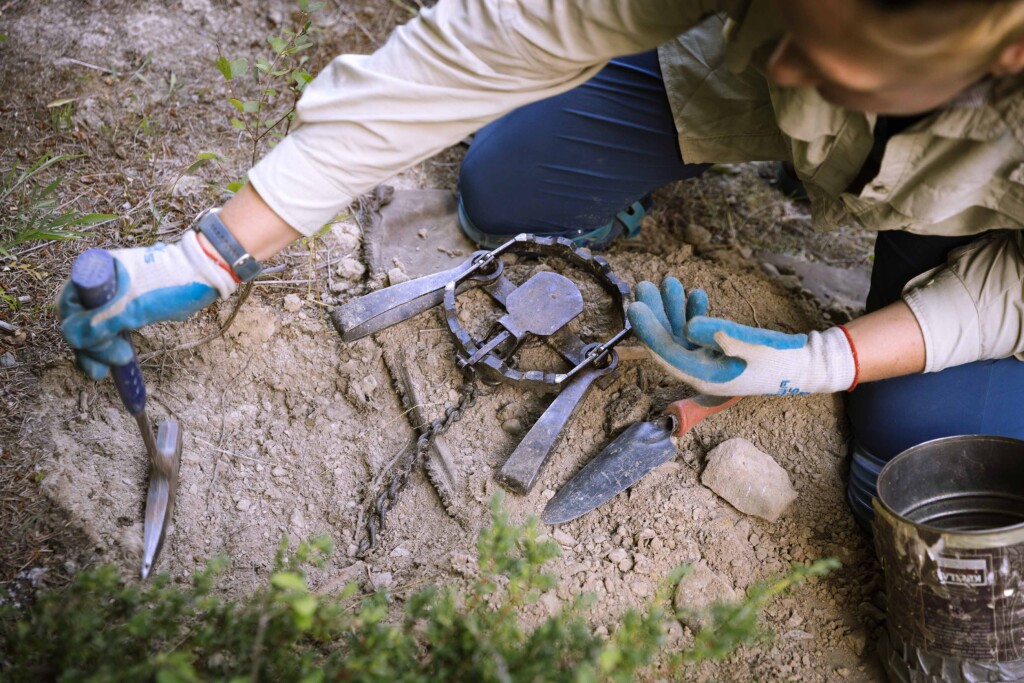
Part 3: Home on the Range
Reports will show you that wolves only kill 0.0034% of livestock in Montana, but I wouldn’t try telling that to Wayne Slaght just now. Looking down at the mangled remains of one of his calves, its eyes bulging and clouded waiting for the birds to come and peck them out, it’s a safe bet that Wayne feels that wolves are both close and hungry. It’s one thing when some fraction of a fraction of a percent of somebody else’s cattle die, but it’s another when one of yours is lying in pieces at your feet. Despite what the stuffed animals in the gift shop might lead you to believe, Wayne sees wolves for one of their most brutal truths.
“They are an animal that kills,” he says. “I think people in town imagine it’s just a nice animal they can hear howl, but they don’t understand that it has to eat to live, and the only thing it eats is meat.”
Wayne has lived in Montana his entire life, and he and his family have managed the Two Creek Monture Ranch near Ovando since the early 1980s. He is no stranger to predators. Looking north from the ranch, you can see the southern edge of the Northern Continental Divide Ecosystem, a landscape home to some 1,100 grizzly bears, many of which end up on Two Creek.
“We have so many grizzlies, but we can’t set wolf traps because of the risk of accidentally catching a bear. My son has had four or five near his house in the last month, and they come in so close he’s even had to chase some out of his yard with a four-wheeler.”
Montana does have laws that allow ranchers to shoot predators that are threatening livestock. After he found the dead calf, Wayne got ahold of wildlife officials who came to the ranch, verified it was indeed a wolf depredation, provided reimbursement for the dead calf, and killed one of the offending wolves. Still, that doesn’t mean every rancher is looking for a chance to extirpate wolves for a second time. The Slaghts use an expansive suite of non-lethal approaches to reduce wolf conflict and protect their herd.
A fladry perimeter, for example, uses strips of thin, rectangular flags attached to an electrified line that flap around in the wind. The waving fabric is unnerving to wolves, and typically they avoid it altogether. Those bold enough to nose the line get a shock that drives them out. The problem is that wolves are smart, and fladry loses its novelty after about 90 days, and they find a way to slip past it. However, when timed effectively, it can be quickly unspooled from the backs of snowmobiles and erected to create a useful barrier during early calving season when newborns are most vulnerable.
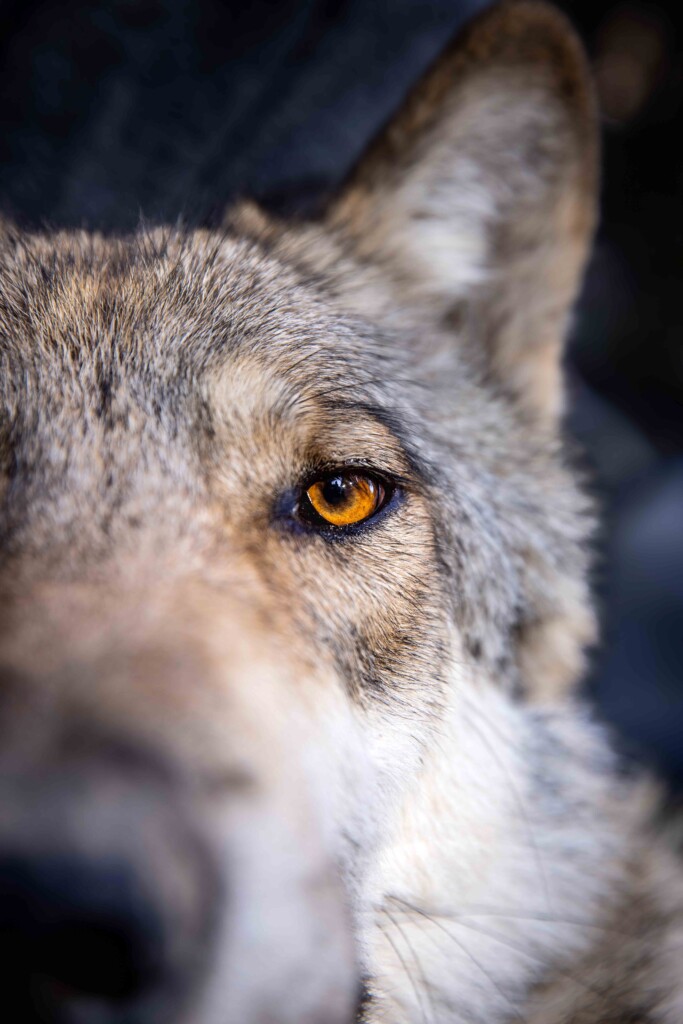
Wayne also collaborates with groups like FWP, Montana Wildlife Services, the Blackfoot Challenge, and Defenders of Wildlife to adopt the use of five-wire electric fencing, fox lights, and steel grain storage bins. He hires range riders to patrol grazing land, participates in carcass removal programs to decrease attractants, and has installed drive-over electrified mats that zap any paws that try to cross them. Lethal removal of predators isn’t something that he wants to do on a regular basis, but he has to keep his options open to protect the land he manages.
“I’m more than happy to do as much non-lethal stuff as possible,” Wayne says, “but when it comes to the point that wolves are killing calves, then we have to have the ability to put some down. We have to have every tool in the toolbox available, and one of those tools is having the ability to kill wolves.”
His approach is working. Despite working in an area with some of the densest predator concentrations in the country, this is the first wolf depredation he’s had in 14 years. His efforts and success earned him a Montana Environmental Stewardship Award from the Montana Stockgrowers Association in 2017. While some might be uncomfortable with the idea of ranchers being able to kill wolves at all, they’d be wise to remember a commodity ranchers provide wolves that is critical for their survival: connected habitat.
At a time when Montana is experiencing a surge of new tourists and residents, land is at an ever-increasing premium. Census data show that the state’s human population has grown by nearly 6% in the past five years, and with that comes demand for new development. Those homes, businesses, and streets — not to mention increased recreation pressures — put a strain on the landscapes wolves rely on.
In addition to running cattle, ranches like Two Creek act as conduits that connect ecosystems in important ways. A wolf might be killed if it attacks a cow, but it will almost certainly be killed if it attacks someone’s dog in the new housing development that went up where rangeland used to be.
“You’ve got some folks who don’t want to kill anything, who’ve got their head in the sand as to what it’s like actually living with wolves,” Wayne says. “Then you’ve got the other side saying, ‘Kill them all,’ but we can’t do that either. There’s got to be a happy medium where we can live with them but still make a living for ourselves.”
Part 4: Singular Focus
The pickup rolls to a stop. Wendy turns off the radio and stares out through the bug-smeared windshield. Thirty yards away, the wolf paces, its front paw hobbled by the rubber jaws clamped around it. Its eyes dart to the forest and then back down the road. The thrashed juniper next to the trap site suggests the wolf has been trying to escape most of the night, but the chain only allowed it to move three feet in any direction. Usually on morning trap checks, Wendy jokes and listens to podcasts about The Office or whatever local station is playing the Eagles, but right now everything is washed quiet in singular focus. She moves fast and slow at the same time. Her hands know exactly where they need to be, but nothing is rushed. She taps a message on the InReach to call April over, then gets to work prepping a GPS collar, assembling a jab stick, and documenting. Always documenting.
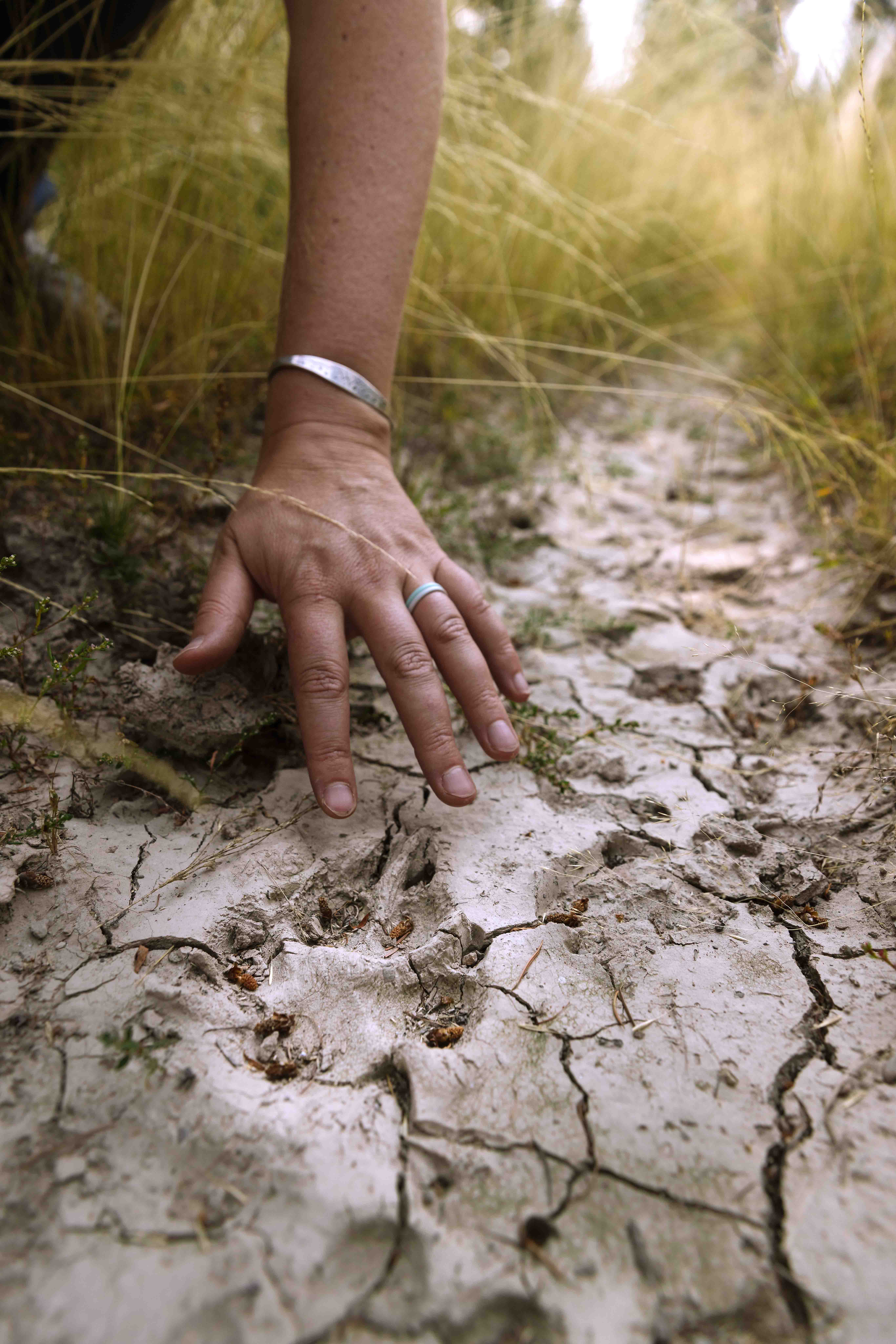
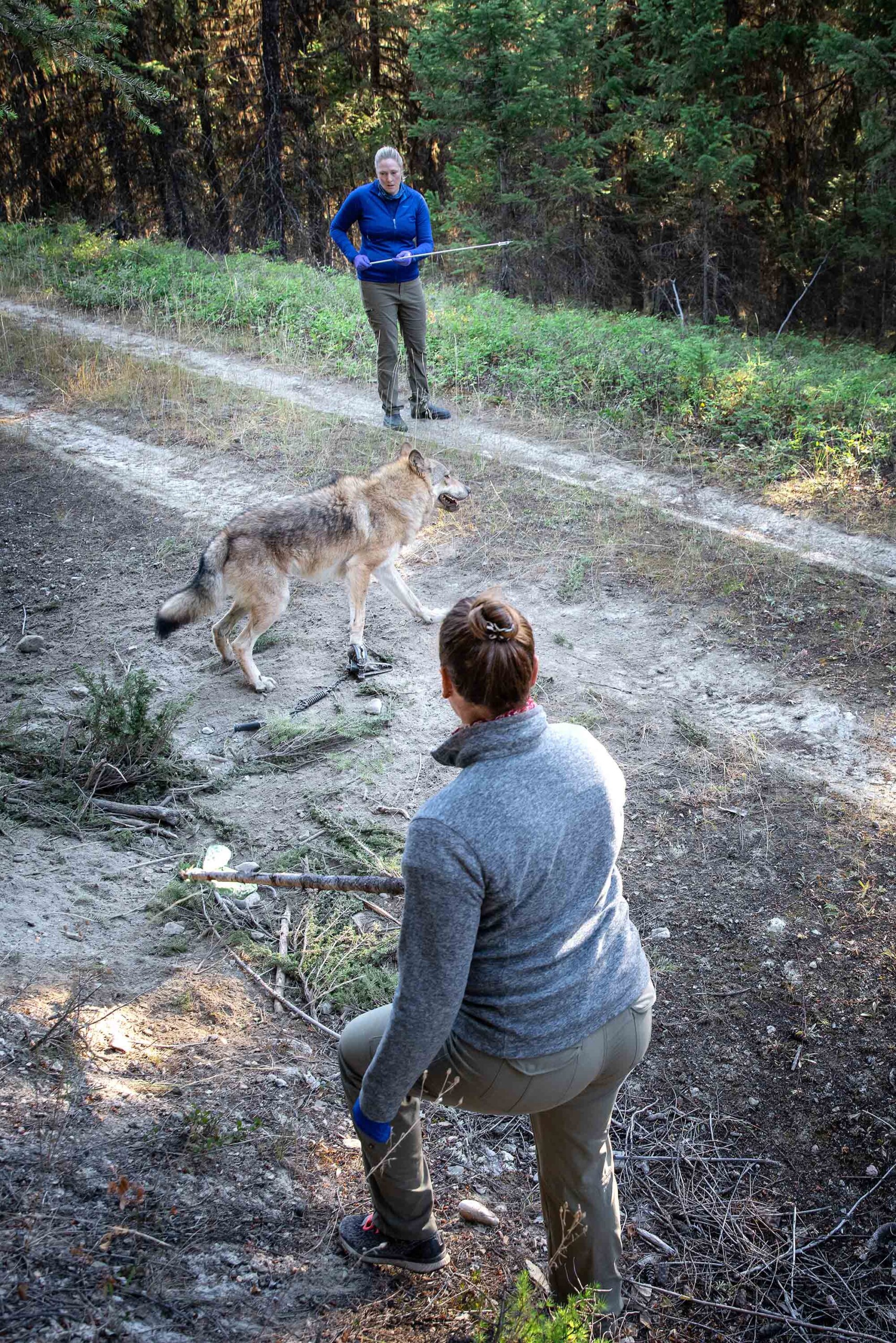
By the time April arrives, things are in place, and she falls quickly into Wendy’s rhythm. They load a syringe with Telazol to sedate the wolf, then walk toward it without hesitation. April waves a flag to distract the snarling animal as they close the gap. Wendy sees the opening, sidesteps, and plunges the needle into its thigh. They let the drugs kick in and release its paw from the trap. Now they have about 90 minutes until it wakes up.
They talk in low tones, taking turns screening the animal and jotting down notes. They determine its age and sex, a one-and-a-half year old male. Weight, 80 pounds. Vital signs, stable. Healthy, no visible signs of worms or infection but missing one premolar. They collect hair and blood samples for DNA analysis. April peels back his lip and measures his canine teeth while Wendy sizes the collar and secures it around his neck. Repeat vital signs.
Wendy leans in to check his breathing. She presses her stethoscope onto the torso of the wolf — an animal the rest of the world either forgot or counted twice without knowing it. Most will never even see a wolf in northwestern Montana, but anybody with a strong stance can find a reason to hate Wendy Cole: either her research stops them from killing the wolves they’re entitled to, or it justifies hunting quotas that call for the wholesale slaughter of the most iconic predator in North America. Crouched over an unconscious carnivore on an old logging road, Wendy and April do the unfashionable work of holding together the middle.
Once their work is completed, they step back a safe distance to monitor the wolf until he’s able to return to the forest under his own power. April hands me the binoculars. I watch a streak of black fur run from his hackles to his tail, past the grays and browns that seem to change color in the sunlight as his chest rises and falls. Buried in all the controversy, it’s easy to get so wrapped up in the idea of wolves that you forget they’re actually there. I wonder what he’ll think of all this when he wakes up.
Wendy sips her now-cold coffee. “Don’t do it,” she tells me.
“Do what?”
“Everybody tries to see things in wolves that may or may not be there.” She shrugs, knowing she read my mind. “It’s hard not to. Part of the reason people are so passionate about them is because they see some of a wolf’s characteristics in themselves, for better or worse. The only place a wolf can be a devil or a saint is in the eye of the beholder. They’re amazingly resilient, and that’s because they have to be in order to survive, and trying to say that they’re cruel or ruthless or angelic or benevolent is doing them a disservice from either direction.”
After a couple of attempts, he rises and staggers, sprawling out wide for balance as the Telazol leaves his bloodstream. He shakes his head to adjust his new collar, then squares his body and looks right through us for a time that feels longer than it is. He turns and trots down the road, disappearing into the trees that in turn disappear into the wildfire haze and the shrouded mountains. Soon he’ll unknowingly provide data that will refine a system to allow wildlife managers, and hopefully legislators, to act on better information, but there are no guarantees. In the tug between dogma and data, there is no promise that what the wolf provides will change any hearts or minds, even if he manages to survive the upcoming season.
Wendy pauses for a moment, watching where the wolf slipped through the trees, through the smoke that hides mountains. She studies her surroundings, taking mental notes that will allow her to navigate an increasingly complicated landscape. The weight of wolves is on her shoulders, and will be, until an entire state comes to an agreement on what to do with them. That’s something she can count on.
Related Stories

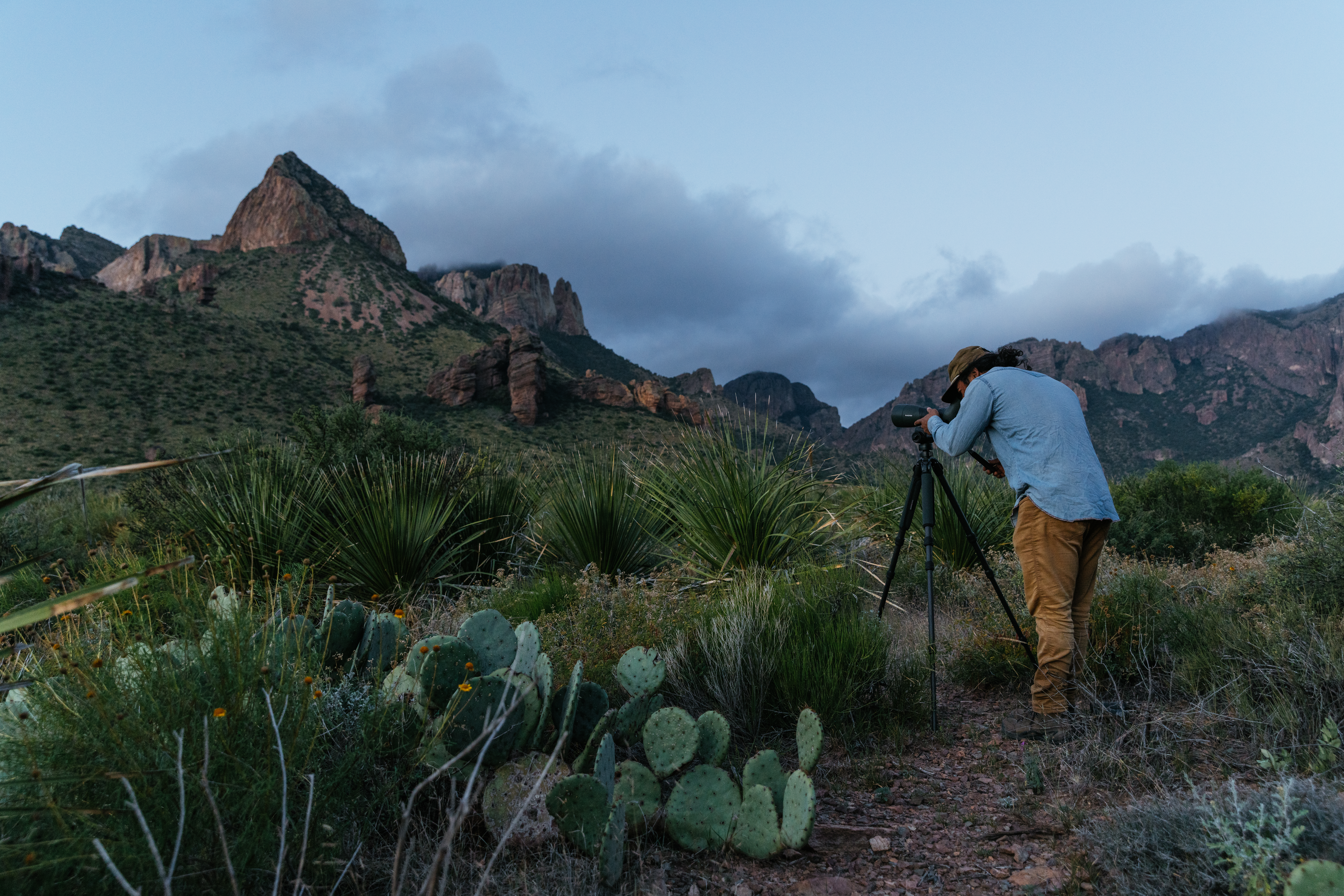
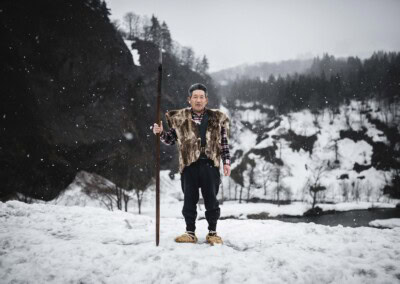
Latest Stories


